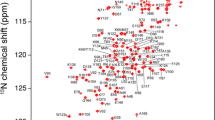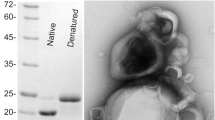Abstract
Several studies have been made to characterize the molecular properties and activity of Sticholysin II (StnII), a 175 amino acid protein secreted by the sea anemone Stichodactyla helianthus. In particular, the biochemical characterization of different mutants of this protein have been shown to be essential for the rational understanding of its activity. Here we report the nearly complete NMR 15N, 13C and 1H chemical shift assignments, at pH 4.0 and 25°C, of a less hemolytic and defective lipid binding mutant of StnII, the R29Q variant (BMRB no 16362).


Similar content being viewed by others
References
Alegre-Cebollada J, Oñaderra M, Gavilanes JG, Martínez del Pozo A (2007a) Sea anemone actinoporins: the transition from a folded soluble state to a functionally active membrane-bound oligomeric pore. Curr Protein Pept Sci 8:558–572
Alegre-Cebollada J, Clementi G, Cunietti M, Porres C, Oñaderra M, Gavilanes JG, Martínez del Pozo A (2007b) Silent mutations at the 5′-end of the cDNA of actinoporins from the sea anemone Stichodactyla helianthus allow their heterologous overproduction in Escherichia coli. J Biotechnol 127:211–221
Alegre-Cebollada J, Cunietti M, Herrero-Galán E, Gavilanes JG, Martínez-del-Pozo A (2008) Calorimetric scrutiny of lipid binding by sticholysin II toxin mutants. J Mol Biol 382:920–930
Anderluh G, Macek P (2002) Cytolytic peptide and protein toxins from sea anemones (Anthozoa: Actiniaria). Toxicon 40:111–124
Athanasiadis A, Anderluh G, Macek P, Turk D (2001) Crystal structure of the soluble form of equinatoxin II, a pore-forming toxin from the sea anemone Actinia equina. Structure 9:341–346
Castrillo I, Alegre-Cebollada J, Martínez-del-Pozo A, Gavilanes JG, Santoro J, Bruix M (2009) 1H, 13C, and 15N NMR assignments of the actinoporin Sticholysin I. Biomol NMR Assign 3:5–7
Goddard TD, Kneller DG (2005) SPARKY 3. University of California, San Francisco
Hinds MG, Zhang W, Anderluh G, Hansen PE, Norton RS (2002) Solution structure of the eukaryotic pore-forming cytolysin equinatoxin II: implications for pore formation. J Mol Biol 315:1219–1229
Mancheño JM, Martín-Benito J, Martínez-Ripoll M, Gavilanes JG, Hermoso JA (2003) Crystal and electron microscopy structures of sticholysin II actinoporin reveal insights into the mechanism of membrane pore formation. Structure 11:1319–1328
Parker MW, Feil SC (2005) Pore-forming protein toxins: from structure to function. Prog Biophys Mol Biol 88:91–142
Acknowledgements
This paper was supported by projects CTQ2008-00080/BQU and BFU2006-04404 from the Spanish Ministerio de Ciencia e Innovación.
Author information
Authors and Affiliations
Corresponding author
Rights and permissions
About this article
Cite this article
Castrillo, I., Alegre-Cebollada, J., Martínez-del-Pozo, Á. et al. 1H, 13C, and 15N NMR assignments of StnII-R29Q, a defective lipid binding mutant of the sea anemone actinoporin Sticholysin II. Biomol NMR Assign 3, 239–241 (2009). https://doi.org/10.1007/s12104-009-9184-2
Received:
Accepted:
Published:
Issue Date:
DOI: https://doi.org/10.1007/s12104-009-9184-2




